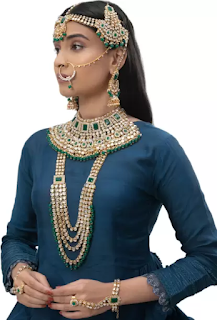The Science Behind Indian Jewellery
One's beauty can be enhanced by jewellery. Additionally, it represents prestige, riches, and power. Some people use jewellery as a means of self- and artistic expression. Then there are those who incorporate jewellery into their culture and custom. Jewelry has symbolic meaning. Particularly at weddings, they have symbolic ethnic and religious implications. The bridal jewellery serves as a symbol that the woman will join her husband's extended family. They are a component of the ceremony of cleansing as she joins her bridegroom's extended family.
TOE RING
Married Hindu women in India frequently wear toe rings, also
known as bicchiya. The bicchiya, which are often made of silver metal, are worn
in pairs in the second toes of both foot. Women wear them as a lifetime mark of
their marital status and never take them off. The social and religious
significance of toe rings is well known, but little is known about the silver
toe rings' potential health advantages.
TOE RINGS' INCREDIBLE HEALTH BENEFITS
According to Ayurveda, the woman's uterus is directly
connected to the nerve on her second toe. Therefore, it is known that a little
pressure can control the menstrual cycle. It is also recognised to maintain
uterine health.
The bicchiya is traditionally worn on the second toe of the
foot by married ladies, while the third toe is reserved for single women.
Unmarried women are allegedly helped by putting a silver toe ring on their
third toe to eliminate or at least lessen period pain.
THE BENEFITS OF ACUPRESSURE
Toe rings are also thought to have potential benefits for
acupressure. This is because they exert pressure on certain nerves in the feet
that are known to support a woman's reproductive system.
BANGLES
Ancient times are when Indian ladies first started wearing
bangles. Bangles or wrist jewellery are a popular accessory among Indian women to accentuate their
grace and beauty. The old phrases Bangri or Bangali, which in Sanskrit indicate
"the jewellery that adorns the arm," have given rise to the word
bangle.
In India, both married and single women can accessorise with
bangles. There is historical proof that Indian ladies have been
bangle-accessorizing their arms since ancient times. The bronze sculpture of a
dancing girl discovered at Mohenjo Daro, one of the earliest works of art in
India, best captures the age and ubiquity of wrist jewellery in India. The
figurine is barefoot and holding her other arm, which is entirely weighed down
by a bunch of bangles, at her hip.
Men used to go work in farms and forests, which required a
lot of physical labour, while women handled all of the domestic chores in
ancient times. Even though there is a lot of work involved in home duties, it
pales in comparison to a man's work. High blood pressure can result from
staying at home and not doing much physical activity, which causes
irritability, rage, and despair.
Our wrists typically move constantly. Even our pulse is only
checked on our wrists in the event of any ailments or examinations. As a result
of frequent friction between the wrists and the bangles, the blood circulation
level rises. Our energy levels are also maintained and recharged by bangles.
The ring-shaped bangles cause the electricity that escapes through the skin to
return to our own body. Because bangles are round in design, there are no ends
where the energy may be passed outside, causing it to be returned to the body.
2. AUDIO STIMULI ARE DESIRED BY THE FOETUS
Bangles are traditionally given to a woman at her baby
shower in India. A scientific study claims that a baby's brain cells begin to
form and the new-born begins to recognise sounds during the seventh month of
pregnancy. Bangles' tinkling sound gives a newborn auditory stimulation.
According to studies, listening to upbeat or relaxing music during pregnancy
helps the foetus develop its hearing abilities and lowers a pregnant woman's
stress and melancholy. According to gynaecologists, a stressed-out pregnant
lady is more likely to deliver a premature or underweight kid.
3. MORAL EQUALITY
According to a study done on women wearing glass bracelets
vs those made of other synthetic materials, glass bracelets vibrate, act as
pacifiers, and moderate powerful emotions. In the trials, it was discovered
that people wearing non-glass bangles reacted restlessly and overly emotionally
to certain stimuli and situations.
ANKLET
Every lady aspires to own a sizable collection of gold and
silver jewellery. You can learn from a variety of sources that wearing
jewellery has a scientific basis.
Our grandmothers frequently advise us to wear anklets,
bangles, and other jewellery. Every single item has a scientific explanation,
as we can see.
The anklets are what give women's feet a lovely appearance.
When wearing the anklets, silver is the material of choice. One of the classic
pieces of jewellery that dates back to ancient times is the silver anklet.
Silver anklets are worn for a scientific reason. One can
re-vibrate their own body's energy by wearing anklets.
Anklets made of silver can help with leg discomfort and
numbness. This explains why many grandmas who upheld Indian custom are still
active today. It has been learned from several sources that wearing silver
anklets would ease pain from painful cracked heels and swollen heels. They also
assist in regulating blood circulation in the body.
NOSE PINS
Since ancient times, nose jewellery has played a crucial
role in Indian women's fashion. From place to region, nose rings have different
meanings. Hindu traditions dictate that the bride wears the nose stud, or
"nath," on the day of her wedding. The Hindu practise of nose
piercing involves wearing nose rings on either the left or right side.
Although it is now worn by everyone as a fashion accessory,
there are several scientific justifications for why it has been conventional
for women to wear nose rings.
According to studies, the nose, one of the six sense organs,
controls a variety of sentiments and emotions, including sexual, energetic, and
sentimental ones in addition to being a sense organ that aids in breathing and
smelling different aromas. Nose pins are associated with emotionally stable
women. It has been proven that women wearing nose pins are challenging to
mesmerise or cast spells on.
2. IMPROVES OVARY
The point of piercing in the nostril strengthens the
ovaries, causing positive changes in a woman's sexuality and creating ideal
physical conditions for childbirth. The majority of traditions demand that
girls who are prepared for marriage have their nostrils pierced and wear nose
pins for this reason.
The acupressure points on the nose that is pierced
corresponds to the delivery, and when the nose is pierced at this location,
women have less discomfort and fewer difficulties during birth.
Women who wear Hindu jewellery do so primarily to absorb
positive energy and lessen the suffering caused by negative energies. According
to popular belief, women who are highly sensitive should wear large jewellery as
this would activate their Raja-guna and awaken their warrior spirit.
Additionally, the majority of the body is coated in positive
energy as a result of large ornaments, making it more difficult for bad
energies to penetrate the woman's body.
Jewel ought to be an organic extension of you. Anything that
identifies your Persona, from your Names to your Fingerprints to your Voice.




Comments
Post a Comment